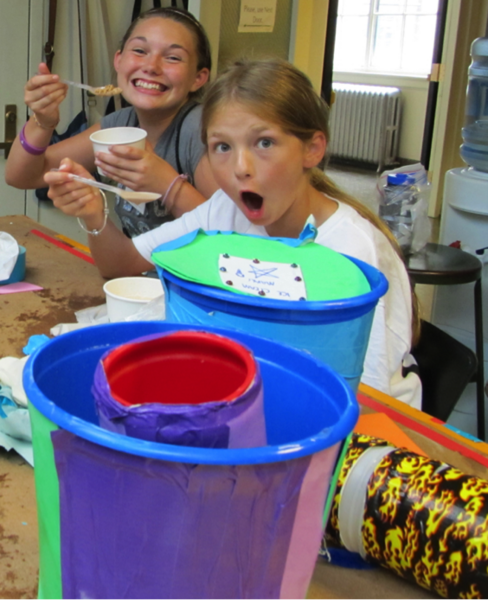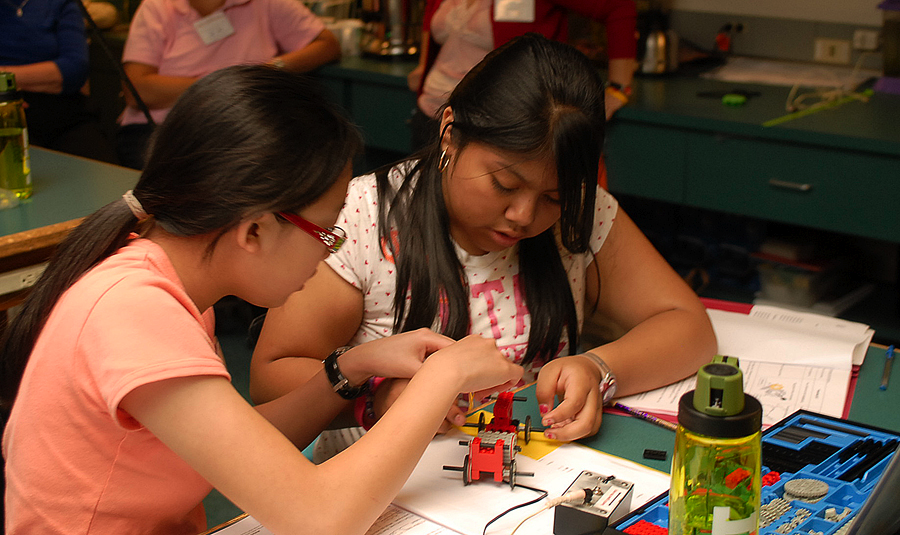Discovering the delights of hands-on science and engineering, 24 rising seventh-graders from Lynn, Mass., spent a week in July at the MIT Edgerton Center, soldering electrical connections, creating lip balm, sewing wearable circuits, inventing ice cream makers and programming their own computer games.
The GE Girls at MIT summer program, funded by General Electric (GE) and developed by members of the GE Women’s Network, the MIT Edgerton Center and the Lemelson-MIT Program, aimed to interest girls in science and technology, and ultimately increase the number of woman engineers.
Each day the girls dove into activities organized around the themes of engineering, construction, computer programming, electronics, aviation and chemistry. Amy Fitzgerald and Jessica Garrett of the MIT Edgerton Center developed and taught most of the lessons, assisted by female GE mentors, MIT undergraduates and two sixth-grade teachers from Lynn.
Garrett and Fitzgerald chose activities designed to be flexible and approached in multiple ways. For example, the girls planned and built paper-card houses with the aim of making the biggest, strongest, “coolest” structure with the fewest number of cards. Though most groups built flat structures, one group created a three-tower skyscraper taped together in coordinating colors. With its substantially greater area and high “coolness” factor, this structure scored several times higher than the competitors.
Fitzgerald commented, “This activity shows them that there’s more than one right answer in engineering. I love when kids finally look up from their own project and say, ‘Oh, theirs is totally different! What if we try ...,' and, like real engineers, borrow from each other and improve what they are doing.”
Another highlight was designing and creating a 30-second video game with help from staff members from MIT’s Scheller Teacher Education Program. Daniel Wendel and Wendy Huang led the session, and every table of four students had an undergraduate help them step by step through the process, creating games that were both challenging and humorous.
Garrett noted, “The week completely changed their view about what science is. They thought that science was only reading about what old guys in white coats discovered long ago, but afterward they were saying, ‘We never knew science was so much fun! Making lip balm is science! I can sew a circuit with metal thread and make an LED light up!’ On their surveys, most of them wrote that they had learned about a lot of new careers.”
“Our plan was to clue the girls in to as many careers as possible that they don’t know about,” says Fitzgerald, who remained unflappable amid excited middle schoolers. “If we can show them that there is such a thing as mechanical engineering and every day they use things made by mechanical engineers, then maybe they will want to be one.”
An integral part of the program were the GE mentors — including an MIT alumna and mother of a current MIT student — who shared their own science and engineering background and career choices with the girls. From Leigh Estabrooks, invention education officer with Lemelson-MIT, the girls learned about her previous career as a scientist working in product development for soft drink and cosmetics companies.
On a more general level, one girl wrote that she learned “not only boys can be engineers.” Another realized, “that everything I love is actually science. I learned that I could have a career in science. This program has opened a lot of doors for me that I thought would always stay closed and it has really brightened my horizons.”
The GE Women’s Network has worked for 14 years to attract young women to science-based jobs and help them develop their talents. After this successful pilot, the group plans to create more “GE Girls at” programs at other universities. Joanne Kugler, leader of the GE’s Women and Technology Initiative, said of the program, “Our vision is to excite young girls around STEM [Science, Technology, Engineering and Math] and retain their interest as they head into high school, college and eventually the workforce (and maybe they’ll even work at GE).”
Fitzgerald pointed out, “We won’t know for years whether this group will end up studying science,” while Garrett added, “But they wrote on their surveys that they want to go to college now … and they want to come to MIT.”
Established in 1992, the MIT Edgerton Center continues the mens et manus (mind and hand) legacy of beloved Institute Professor Harold (Doc) Edgerton who believed that learning by doing was integral to an MIT education. For MIT students, the center supports student teams in engineering competitions, offers hands-on classes and workshop space, and engages students in service projects in developing countries. Outside of MIT, the center advances kindergarten to 12th grade hands-on Science, Technology, Engineering and Math (STEM) education through on-site workshops and intensive summer programs for youth, distribution of curricula developed at the center, and professional development workshops for teachers.
The GE Girls at MIT summer program, funded by General Electric (GE) and developed by members of the GE Women’s Network, the MIT Edgerton Center and the Lemelson-MIT Program, aimed to interest girls in science and technology, and ultimately increase the number of woman engineers.
Each day the girls dove into activities organized around the themes of engineering, construction, computer programming, electronics, aviation and chemistry. Amy Fitzgerald and Jessica Garrett of the MIT Edgerton Center developed and taught most of the lessons, assisted by female GE mentors, MIT undergraduates and two sixth-grade teachers from Lynn.
Garrett and Fitzgerald chose activities designed to be flexible and approached in multiple ways. For example, the girls planned and built paper-card houses with the aim of making the biggest, strongest, “coolest” structure with the fewest number of cards. Though most groups built flat structures, one group created a three-tower skyscraper taped together in coordinating colors. With its substantially greater area and high “coolness” factor, this structure scored several times higher than the competitors.
Fitzgerald commented, “This activity shows them that there’s more than one right answer in engineering. I love when kids finally look up from their own project and say, ‘Oh, theirs is totally different! What if we try ...,' and, like real engineers, borrow from each other and improve what they are doing.”
Another highlight was designing and creating a 30-second video game with help from staff members from MIT’s Scheller Teacher Education Program. Daniel Wendel and Wendy Huang led the session, and every table of four students had an undergraduate help them step by step through the process, creating games that were both challenging and humorous.
Garrett noted, “The week completely changed their view about what science is. They thought that science was only reading about what old guys in white coats discovered long ago, but afterward they were saying, ‘We never knew science was so much fun! Making lip balm is science! I can sew a circuit with metal thread and make an LED light up!’ On their surveys, most of them wrote that they had learned about a lot of new careers.”
“Our plan was to clue the girls in to as many careers as possible that they don’t know about,” says Fitzgerald, who remained unflappable amid excited middle schoolers. “If we can show them that there is such a thing as mechanical engineering and every day they use things made by mechanical engineers, then maybe they will want to be one.”
An integral part of the program were the GE mentors — including an MIT alumna and mother of a current MIT student — who shared their own science and engineering background and career choices with the girls. From Leigh Estabrooks, invention education officer with Lemelson-MIT, the girls learned about her previous career as a scientist working in product development for soft drink and cosmetics companies.
On a more general level, one girl wrote that she learned “not only boys can be engineers.” Another realized, “that everything I love is actually science. I learned that I could have a career in science. This program has opened a lot of doors for me that I thought would always stay closed and it has really brightened my horizons.”
The GE Women’s Network has worked for 14 years to attract young women to science-based jobs and help them develop their talents. After this successful pilot, the group plans to create more “GE Girls at” programs at other universities. Joanne Kugler, leader of the GE’s Women and Technology Initiative, said of the program, “Our vision is to excite young girls around STEM [Science, Technology, Engineering and Math] and retain their interest as they head into high school, college and eventually the workforce (and maybe they’ll even work at GE).”
Fitzgerald pointed out, “We won’t know for years whether this group will end up studying science,” while Garrett added, “But they wrote on their surveys that they want to go to college now … and they want to come to MIT.”
Established in 1992, the MIT Edgerton Center continues the mens et manus (mind and hand) legacy of beloved Institute Professor Harold (Doc) Edgerton who believed that learning by doing was integral to an MIT education. For MIT students, the center supports student teams in engineering competitions, offers hands-on classes and workshop space, and engages students in service projects in developing countries. Outside of MIT, the center advances kindergarten to 12th grade hands-on Science, Technology, Engineering and Math (STEM) education through on-site workshops and intensive summer programs for youth, distribution of curricula developed at the center, and professional development workshops for teachers.







